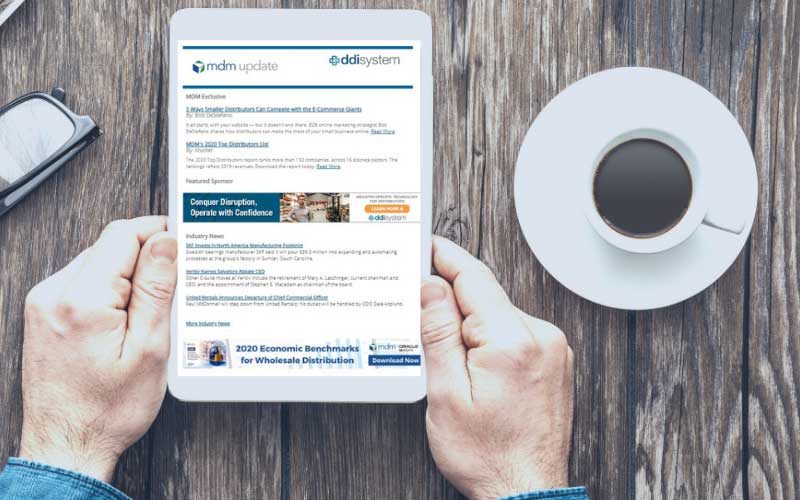The question of tariffs is not new. During President Donald Trump’s first term, the U.S. implemented significant tariffs, notably targeting Chinese imports. These measures aimed to reduce trade deficits and bolster domestic manufacturing. However, the tariffs led to increased costs for imported goods, which distributors often passed on to consumers, resulting in higher prices across various sectors. Many distributors faced challenges such as supply chain disruptions, increased operational costs and the need to renegotiate supplier contracts. Some adapted by diversifying their supplier base or shifting sourcing to countries not subject to tariffs. Overall, the tariffs introduced complexities that required distributors to reassess their strategies to maintain profitability and competitiveness.
But the context and the environment have changed since 2017. We have gone through the COVID-19 pandemic, extreme supply chain disruption and a disruptive inflationary period. We are also in a tense geopolitical environment where war, cybersecurity and infrastructure sabotage is part of the new risk management agenda.
Anticipated Impact of 2025 Tariffs on the Distribution Sector
As the U.S. prepares for potential new tariffs in 2025 — as previously communicated by President-elect Trump — distributors must brace for several challenges:
- Increased Operational Costs: Tariffs on imported goods will likely raise procurement expenses and cost base, squeezing profit margins.
- Supply Chain Disruptions: New tariffs may necessitate rapid adjustments in sourcing strategies, leading to potential delays and increased logistics costs.
- Market Volatility: Uncertainty surrounding tariff implementations can cause fluctuations in demand and pricing, complicating inventory and financial planning.
- Efficiency and Productivity Strain: Tariffs may happen, be short-term or may be rescinded. For every situation, the amount of work to be done across each function might require a large amount of organizational bandwidth especially when technology is not available.
Nothing new there. What is new is the potential immediate retaliation from impacted countries and strategic shift in supply allocation in countries or regions without tariffs.
Proactive Measures for Pricing Strategies for 2025
In anticipation of potential tariffs, some advise distributors to immediately refine their pricing approaches for 2025 in the following ways:
- Work closely with procurement and supply chain teams: The next three-to-four weeks are crucial to identify the extent of the impact, evaluate the cost implications and start developing appropriate plans. Some distributors have already gotten started and have probably placed large orders in anticipation of tariffs.
- Manage cost-plus pricing: When the main pricing approach is cost-plus in nature, immediately adjust prices based on increased costs due to tariffs to ensure margins are maintained while remaining competitive. The last few years have shown that customers are more educated about cost increases due to inflation. In B2B, customers are anticipating a direct cost pass-through.
- Price more dynamically: If you have pricing management and optimization systems in place, utilize real-time data to adjust prices in response to market demand and cost fluctuations. The key word here is dynamic. It is much more than changing prices once and twice a year. It might be every month in 2025.
- Embrace value-based pricing: Emphasize the value propositions of products to justify price adjustments to customers especially for differentiated and unique products that might become too expensive. To avoid customer backlash and losses in demand, remind customers of the value they receive.
- Transparent communication: No one knows what the future holds. It is now important to communicate with customers and not wait for January or February 2025. Clearly explain price changes to customers, highlighting the external factors influencing costs.
The potential tariffs in 2025 present significant challenges for distributors, reminiscent of the hurdles faced during the 2016–2017 period. By proactively diversifying supply chains, investing in technology and adopting flexible pricing strategies, distributors can better navigate the complexities of the evolving trade environment and maintain their competitive edge.
The Need for Agile and Dynamic Pricing in an Uncertain Trade Landscape
As distributors prepare for potential tariffs in 2025, the uncertainty of trade policies highlights the need for agile and dynamic pricing strategies. These approaches help businesses respond quickly to changes in costs, demand and competition, ensuring profitability and market relevance despite shifting policies.
Agile pricing allows rapid price adjustments to reflect changing costs or market conditions. For example, if tariffs are delayed or canceled, distributors can lower prices to improve margins or capture market share. Conversely, if retaliatory tariffs are imposed, agility ensures new costs are incorporated into pricing without delay, minimizing profit erosion.
Dynamic pricing uses real-time data to adjust prices based on market conditions like inventory levels, competitor pricing, and demand. Predictive analytics can help distributors anticipate demand for tariff-impacted products, optimizing revenue and inventory management.
To succeed, distributors should form cross-functional pricing teams from finance, sales and supply chain functions. These teams can develop scenario-based models to address potential tariff outcomes, enabling swift action regardless of policy changes.
Automating pricing processes is also critical. AI-powered software can analyze market data and recommend real-time adjustments, reducing delays and ensuring competitiveness in a rapidly evolving trade environment.
The Final Word
Disruption is coming. In this unpredictable trade environment, agility and dynamism in pricing are not just competitive advantages — they are necessities. By fostering a flexible organizational structure and leveraging pricing technology to enable real-time decision-making, distributors can mitigate risks and seize opportunities, no matter how the tariff landscape evolves
Related Posts
-
Trump also vowed to raise China tariffs beyond his campaign pledge of 60%.
-
In the wake of Hurricane Helene, we gathered commentary from numerous distributors with locations that…
-
The company said it is preparing to adjust pricing and supply chains to mitigate the…






